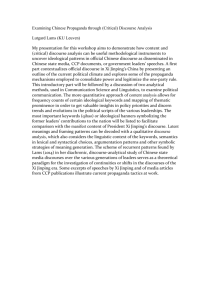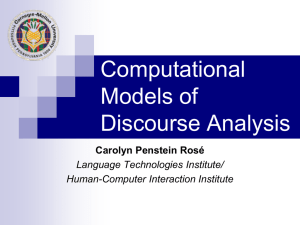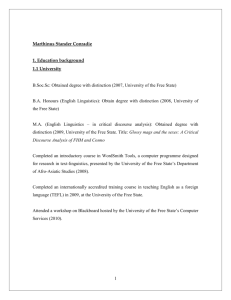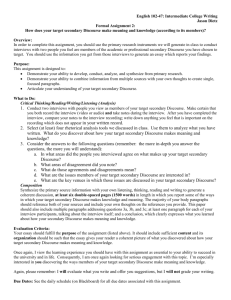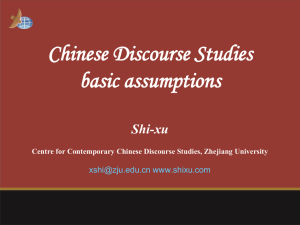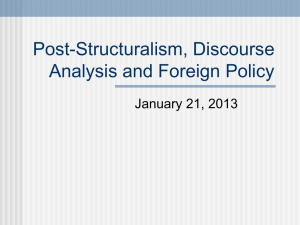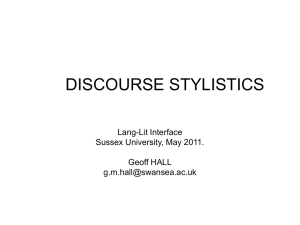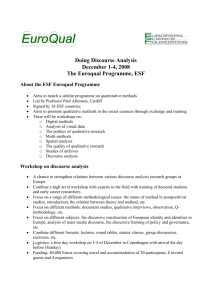Intercultural Communication
advertisement
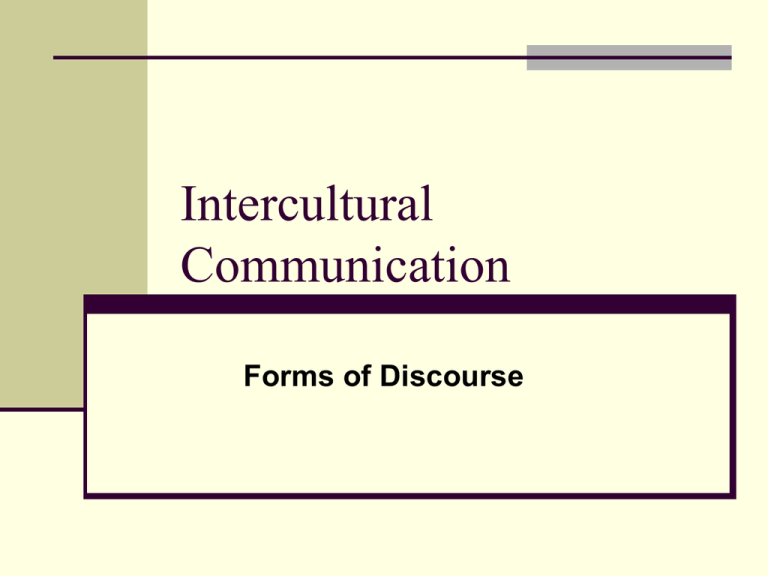
Intercultural Communication Forms of Discourse Review We cannot say anything without positioning ourselves within some ‘discourse system’ Discourse Systems What are the historical/social/ideological characteristics of the group (ideology) What are the preferred or assumed human relationships? (face systems) How does one learn membership and identity? (socialization) What are the preferred forms of communication (forms of discourse) Forms of Discourse Cultural expectations about how discourse/communication works What different kinds of communicative forms should be used for What the purpose/goal of communication is ‘Habits of talk’ / ‘Practiced ways of speaking’ ‘It’s good to talk…’ Honesty is the best policy Be direct Talk is the way you ‘enact your self’ Talk is the way you show yourself to be cooperative Talk is the best way to solve problems ‘Get it out’ Talk=solidarity Silence=uncomfortable/hostile Talking American D. Carbaugh Everyone has a right to his own opinion People should express their ‘true selves’ Talking is the way we legitimate our selves Deborah Tannen The Argument Culture Discourse in America tends to be seen in terms of a debate ‘Don’t talk too much…’ Think before you talk Too much talk can be dangerous Being direct is arrogant or impolite Suzanne Wong Scollon English and Cantonese Metaphors for Talk Beliefs about talking Giles, Coupland and Wiemann 1992 Comparison of American and Chinese beliefs about talk Americans Talk is pleasant, important, a way of controlling what goes on/ Uncomfortable with silence Chinese More tolerant of silence/ Quietness as a way of controlling what goes on Interviews in Alaska Natives White Alaskans Purpose of questions is Purpose of questions is to get you to think about what you have done Talking about future plans is bad luck to get information Need to talk about what you will do next Athabaskan Medical Interviews Doctors Patients don’t talk Patients are uncooperative Purpose of talk is to get information Directness is desirable Patients Doctors don’t listen Doctors ask too many questions Purpose of talk is to get you to think deeply Information comes from observation Directness is insulting Storytelling HIV Patient Medical Interviews in Hong Kong (Jones, Candlin & Yu) Doctors Patients don’t talk Patients are uncooperative Patients don’t understand how to take medicine Purpose of talk: Information Talk is good Talk is a way to solve problems Medical knowledge Patients Doctors don’t listen Doctors ask too many questions Doctors don’t understand how difficult it is to take medicine Purpose of talk: Sharing Talk is dangerous Talk is a way to create problems Experiential knowledge Forms of Discourse: Functions of Language Information vs. Relationship Negotiation vs. Ratification Group harmony vs. Individual welfare ‘Coming Out’ American Man: Have you told your parents? Chinese Man: No. American Man: Why not? Chinese Man: There’s no need. American Man: But don’t you want to be free? ‘Coming Out’ In his study comparing the ‘coming out’ strategies of Caucasian and Chinese gay men in America, Liang (1997) found that Chinese subjects were more likely to talk about the effect disclosure had on other people whereas Caucasian subjects focused more on their individual, internal struggles with the ‘coming out’ process. ‘Coming Out’ Two examples Beautiful Thing Gaylo Seisap What is the purpose of the discourse? What are the assumptions about ‘talking’ What kinds of relationships does the discourse create? What are the preferred forms of discourse? What is the purpose of discourse? Information vs. Relationship Negotiation vs. Ratification Group harmony vs. Individual welfare Forms of Discourse: Utilitarian Discourse System Anti-rhetorical Positivist-empirical Deductive Individualistic Egalitarian Public (intuitionally sanctioned) Individualistic Contradiction Communication should be ‘free’ Communication should be ‘original’ Property metaphor for communication Rights metaphor for communication Institutionally Sanctioned Public discourse The limits to ‘free speech’ ‘Free’ speech is ‘filtered’ by powerful institutions Changes brought on by new media
